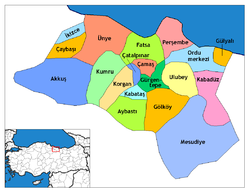Kumru, Ordu
Kumru | |
|---|---|
District | |
 Location of Kumru within Turkey. | |
| Coordinates: 40°52′28″N 37°15′50″E / 40.87444°N 37.26389°E | |
| Country | |
| Region | Black Sea |
| Province | Ordu Province |
| Government | |
| • Mayor | Yusuf Yalçuva (AKP) |
| Area | |
| • District | 362.61 km2 (140.00 sq mi) |
| Elevation | 618 m (2,028 ft) |
| Population | |
| • Urban | Template:Turkey district populations |
| • District | Template:Turkey district populations |
| Time zone | UTC+2 (EET) |
| • Summer (DST) | UTC+3 (EEST) |
| Postal code | 52xxx |
| Area code | 0452 |
| Licence plate | 52 |
| Climate | Cfb |
| Website | www.kumru.bel.tr |
Kumru is a town and district of Ordu Province in the Black Sea region of Turkey. According to the 2000 census, population of the district is 44,307 of which 18,057 live in the town of Kumru.[2][3]
Geography
The district covers an area of 363 km2 (140 sq mi),[4] and the town lies at an elevation of 618 m (2,028 ft).
Kumru is a small, remote town sandwiched between two mountains, 33 km inland from the Black Sea coast. Kumru is located approximately thirty-five kilometers southwest of Fatsa. The distance to Ordu is seventy kilometers. It borders four cities and towns: Korgan, Akkus, Fatsa, Unye, and Niksar. Ortaca which is locally known as Gebekse meaning Gebe Kilise is a village of Kumru. Ortaçokdeğirmen which got its name from the mills built on the rivers is another village of Kumru. It is located on the sides of Canik mountains and about 15 minutes to Ericek plateau where the most delicious mountain strawberry is naturally grown. It is possible to see 23 shades of green around Kumru and it is almost impossible to see the brown color of earth due to the vast forests.
Notes
- ^ "Area of regions (including lakes), km²". Regional Statistics Database. Turkish Statistical Institute. 2002. Retrieved 2013-03-05.
- ^ Turkish Statistical Institute. "Census 2000, Key statistics for urban areas of Turkey" (in Turkish). Archived from the original (XLS) on 2007-07-22. Retrieved 2009-04-25.
- ^ GeoHive. "Statistical information on Turkey's administrative units". Archived from the original on 2009-10-15. Retrieved 2009-04-25.
- ^ Statoids. "Statistical information on districts of Turkey". Retrieved 2009-04-25.
References
- Falling Rain Genomics, Inc. "Geographical information on Kumru, Turkey". Retrieved 2009-04-25.
External links
- District municipality's official website (in Turkish)
- Kumru State Hospital (in Turkish)
- Road map of Kumru and environs
- Various images of Kumru, Ordu
- Kumru news portal (in Turkish)
- Kumru news website (in Turkish)



